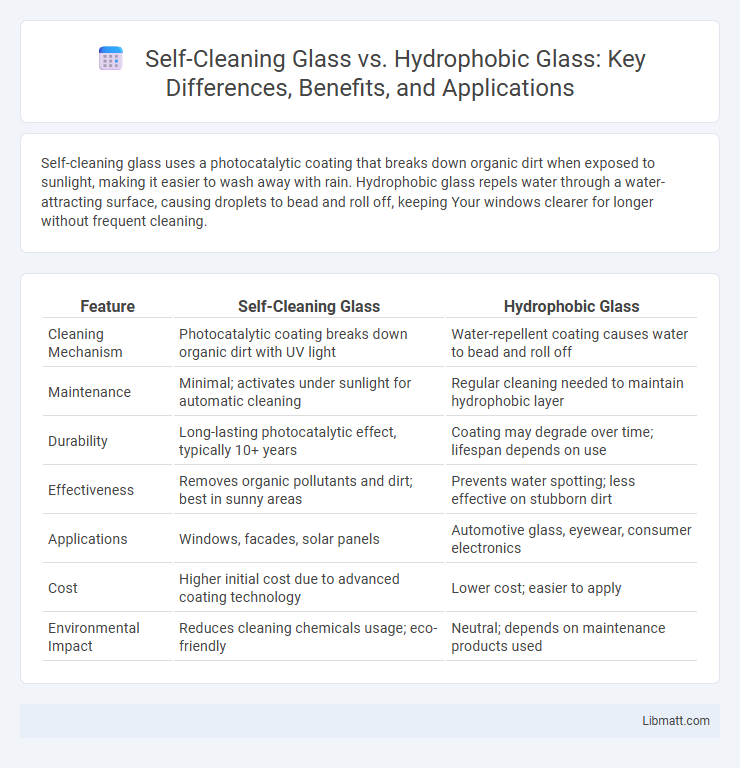Self-cleaning glass uses a photocatalytic coating that breaks down organic dirt when exposed to sunlight, making it easier to wash away with rain. Hydrophobic glass repels water through a water-attracting surface, causing droplets to bead and roll off, keeping Your windows clearer for longer without frequent cleaning.
Table of Comparison
| Feature | Self-Cleaning Glass | Hydrophobic Glass |
|---|---|---|
| Cleaning Mechanism | Photocatalytic coating breaks down organic dirt with UV light | Water-repellent coating causes water to bead and roll off |
| Maintenance | Minimal; activates under sunlight for automatic cleaning | Regular cleaning needed to maintain hydrophobic layer |
| Durability | Long-lasting photocatalytic effect, typically 10+ years | Coating may degrade over time; lifespan depends on use |
| Effectiveness | Removes organic pollutants and dirt; best in sunny areas | Prevents water spotting; less effective on stubborn dirt |
| Applications | Windows, facades, solar panels | Automotive glass, eyewear, consumer electronics |
| Cost | Higher initial cost due to advanced coating technology | Lower cost; easier to apply |
| Environmental Impact | Reduces cleaning chemicals usage; eco-friendly | Neutral; depends on maintenance products used |
Introduction to Self-Cleaning and Hydrophobic Glass
Self-cleaning glass utilizes photocatalytic coatings, typically titanium dioxide, to break down organic dirt when exposed to sunlight, enabling rainwater to wash it away effortlessly. Hydrophobic glass features a water-repellent coating that causes water droplets to bead and roll off, preventing water stains and reducing cleaning frequency. Both technologies enhance maintenance efficiency but operate through distinct mechanisms--photocatalysis for self-cleaning and surface energy reduction for hydrophobic properties.
How Self-Cleaning Glass Works
Self-cleaning glass utilizes a photocatalytic coating, usually titanium dioxide, that breaks down organic dirt when exposed to UV light, facilitating dirt removal through rainwater. This coating also promotes hydrophilicity, causing water to spread evenly and wash away debris without streaks. In contrast to hydrophobic glass that repels water, self-cleaning glass leverages photocatalysis combined with water sheeting, enhancing surface cleanliness efficiently.
The Science Behind Hydrophobic Glass
Hydrophobic glass utilizes surface chemistry to repel water by creating a high contact angle, causing water droplets to bead up and roll off, effectively removing dirt and contaminants. This effect is achieved through nano-scale surface roughness combined with low surface energy coatings, often using materials like fluoropolymers or silica-based compounds. Unlike self-cleaning glass that relies on photocatalytic reactions to break down organic matter, hydrophobic glass relies purely on physical water repellency to maintain cleanliness.
Key Differences Between Self-Cleaning and Hydrophobic Glass
Self-cleaning glass features a photocatalytic coating that breaks down organic dirt using sunlight, while hydrophobic glass repels water through a surface treatment that causes water droplets to bead and roll off. Self-cleaning glass actively decomposes contaminants, reducing the need for manual cleaning, whereas hydrophobic glass primarily prevents water from sticking, minimizing water marks and streaks. Your choice depends on whether you need ongoing dirt decomposition or just water repellency for easier maintenance.
Pros and Cons of Self-Cleaning Glass
Self-cleaning glass uses a special coating that breaks down organic dirt using sunlight and washes it away with rain, reducing maintenance efforts and saving time. This type of glass offers the advantage of clear visibility and sustainability by minimizing the need for chemical cleaners but may be less effective in areas with limited sunlight or heavy dirt buildup. You benefit from its eco-friendly properties, but the higher initial cost and potential durability concerns under harsh environmental conditions are notable drawbacks.
Advantages and Limitations of Hydrophobic Glass
Hydrophobic glass offers the advantage of repelling water and preventing the accumulation of dirt by causing water droplets to bead and roll off its surface, reducing the need for frequent cleaning. Its limitations include lower effectiveness in removing oily or sticky contaminants and vulnerability to abrasion, which can degrade the hydrophobic coating over time. Unlike self-cleaning glass that utilizes photocatalytic properties to break down organic dirt, hydrophobic glass primarily relies on water repellency without actively decomposing contaminants.
Cost Comparison: Self-Cleaning vs Hydrophobic Glass
Self-cleaning glass, typically coated with titanium dioxide, tends to be more expensive upfront than hydrophobic glass due to its photocatalytic and hydrophilic properties that actively break down organic dirt using sunlight. Hydrophobic glass, which repels water and prevents dirt adhesion through a water-resistant coating, generally offers a lower cost option but may require more frequent cleaning. Long-term maintenance costs favor self-cleaning glass, as its ability to reduce manual cleaning expenses can offset the initial higher investment.
Real-World Applications for Each Glass Type
Self-cleaning glass is widely used in architectural applications such as building facades and skylights, leveraging its photocatalytic coating to break down organic dirt under sunlight, reducing maintenance costs for high-rise structures. Hydrophobic glass finds practical application in automotive windshields and solar panels, where its water-repellent properties enhance visibility during rain and improve efficiency by minimizing water accumulation. Both technologies offer tailored solutions to specific industries, with self-cleaning glass excelling in urban environments and hydrophobic glass optimizing performance in transportation and renewable energy sectors.
Maintenance and Longevity Considerations
Self-cleaning glass uses a photocatalytic coating that breaks down organic dirt when exposed to sunlight, reducing the frequency of cleaning and extending its lifespan by preventing grime buildup. Hydrophobic glass features a water-repellent surface that causes water to bead and roll off, minimizing water spots but requiring periodic cleaning to remove oily residues and dust. Both technologies enhance window longevity by reducing maintenance needs, but self-cleaning glass generally offers more comprehensive dirt decomposition for longer-lasting clarity.
Choosing the Right Glass for Your Needs
Self-cleaning glass utilizes photocatalytic coatings that break down organic dirt when exposed to sunlight, making it ideal for windows in sunny environments requiring minimal maintenance. Hydrophobic glass features water-repellent coatings causing water to bead and roll off, effectively preventing water stains on surfaces frequently exposed to rain or moisture. Your choice depends on environmental factors and maintenance preferences, with self-cleaning glass better suited for sunlight exposure and hydrophobic glass offering superior water repellency.
self-cleaning glass vs hydrophobic glass Infographic

 libmatt.com
libmatt.com